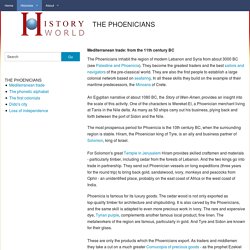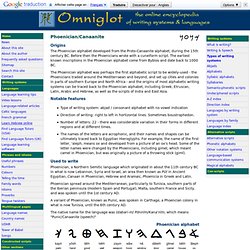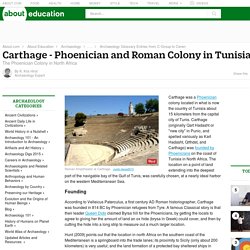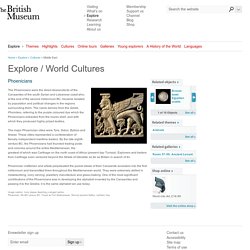

THE PHOENICIANS. Mediterranean trade: from the 11th century BC The Phoenicians inhabit the region of modern Lebanon and Syria from about 3000 BC (see Palestine and Phoenicia).

They become the greatest traders and the best sailors and navigators of the pre-classical world. They are also the first people to establish a large colonial network based on seafaring. Phoenicia. Phoenicia was an ancient civilization composed of independent city-states which lay along the coast of the Mediterranean Sea stretching through what is now Syria, Lebannon and northern Israel.

The Phoenicians were a great maritime people, known for their mighty ships adorned with horses’ heads in honor of their god of the sea, Yamm, the brother of Mot, the god of death. The island city of Tyre and the city of Sidon were the most powerful states in Phoenicia with Gebal/Byblos and Baalbek as the most important spiritual/religious centers. Phoenician city-states began to take form c. 3200 BCE and were firmly established by c. 2750 BCE. Phoenicia thrived as a maritime trader and manufacturing center from c.1500-332 BCE and was highly regarded for their skill in ship-building, glass-making, the production of dyes, and an impressive level of skill in the manufacture of luxury and common goods.
Phoenician alphabet and language. Origins The Phoenician alphabet developed from the Proto-Canaanite alphabet, during the 15th century BC.

Before then the Phoenicians wrote with a cuneiform script. The earliest known inscriptions in the Phoenician alphabet come from Byblos and date back to 1000 BC. The Phoenician alphabet was perhaps the first alphabetic script to be widely-used - the Phoenicians traded around the Mediterraean and beyond, and set up cities and colonies in parts of southern Europe and North Africa - and the origins of most alphabetic writing systems can be traced back to the Phoenician alphabet, including Greek, Etruscan, Latin, Arabic and Hebrew, as well as the scripts of India and East Asia.
Notable features Type of writing system: abjad / consonant alphabet with no vowel indication Direction of writing: right to left in hortizontal lines. Used to write A variant of Phoenician, known as Punic, was spoken in Carthage, a Phoencian colony in what is now Tunisia, until the 6th century AD. Attitudes Toward the Carthaginians and Phoenicians. Sidon - Phoenician City State and Harbor Sidon.
The archaeological site of Sidon includes the ruins of what was an important city-state of the Iron Age civilization of Phoenicia also called Canaan, and the center port for trade between Assyria, Egypt, Cyprus and the Aegean Sea between the sixth and fifth centuries BC.

Located on the Mediterranean coast of Lebanon, Sidon is today still a thriving city and port. Sidon was founded during the Early Bronze Age of the third millennium BC, when it was settled by coastal populations in the natural anchorage. By the beginning of the early Iron Age (between about 1200-1000 BC), Sidon had become an important international trade center. Phoenicians: Sailing Away. The Phoenicians used cuneiform but later developed their own alphabet.

This famous sequence of letters known to much of the world dates back to the 16th century B.C.E. A fairly small group of traders and merchants known as the Phoenicians created the foundation for the modern English alphabet and other alphabets. They organized a system of 22 consonants into what became the alphabet used not only by English speakers, but by speakers of many of the world's languages. The Latest Underwater Discoveries - Phoenician Wreck. (Courtesy INA/Mark Polzer) Phoenician WreckCartagena, Spain Dubbed the "princes of the sea" in the Book of Ezekiel, the Phoenicians sailed from their ports in modern-day Lebanon all the way to the Iberian Peninsula in search of precious commodities.

Trading a costly violet-blue dye, Tyrian purple, and exquisite glasswares, these master navigators and merchants filled their holds with silver and other valuables from about 1200 to 300 B.C. But archaeologists have uncovered little evidence of these ships apart from depictions on reliefs, or much direct proof of the vast extent of their trade networks. Now, a discovery off the coastal city of Cartagena in southeast Spain by archaeologists Mark Polzer and Juan Pinedo of Texas A&M University promises to fill many gaps in our knowledge. On a more human level, the artifacts also promise to tell us much about the diets and lives of Phoenician sailors. More Underwater Discoveries Share. Carthage - Phoenician and Roman Colony in Tunisia. Carthage was a Phoenician colony located in what is now the country of Tunisia about 15 kilometers from the capital city of Tunis.

Carthage (originally Qart Hadasht or "new city" in Punic, and spelled variously as Kart Hadasht, Qrthdst, and Carthago) was founded by Phoenicians on the coast of Tunisia in North Africa. The location on a point of land extending into the deepest part of the navigable bay of the Gulf of Tunis, was carefully chosen, at a nearly ideal harbor on the western Mediterranean Sea. Founding According to Velleicus Paterculus, a first century AD Roman historiographer, Carthage was founded in 814 BC by Phoenician refugees from Tyre.
A famous Classical story is that their leader Queen Dido claimed Byrsa hill for the Phoenicians, by getting the locals to agree to giving her the amount of land an ox hide (brysa in Greek) could cover, and then by cutting the hide into a long strip to measure out a much larger location. Archaeology and Architecture Francis W. Sources. Phoenicians. The Phoenicians were the direct descendents of the Canaanites of the south Syrian and Lebanese coast who, at the end of the second millennium BC, became isolated by population and political changes in the regions surrounding them.

The name derives from the Greek, Phoinikes, referring to the purple coloured dye which the Phoenicians extracted from the murex shell, and with which they produced highly prized textiles. The major Phoenician cities were Tyre, Sidon, Byblos and Arwad. These cities represented a confederation of fiercely independent maritime traders. By the late eighth century BC, the Phoenicians had founded trading posts and colonies around the entire Mediterranean, the greatest of which was Carthage on the north coast of Africa (present day Tunisia). Explorers and traders from Carthage even ventured beyond the Straits of Gibraltar as far as Britain in search of tin. Image caption: Ivory plaque depicting a winged sphinx Phoenician, 9th-8th century BC.
FC13: Masters of the Sea: The Phoenicians (c.1200-500 BCE) It is easy for us today to take sea-borne trade and travel for granted.

But what if no one had dared to venture across the sea? After all, humans do not take naturally to water, and it is conceivable that a natural fear would have kept us complete landlubbers. Phoenicians @ National Geographic Magazine. Who Were the Phoenicians? Inspired by Egypt, obelisks punctuate a temple in Byblos, Lebanon, that was likely dedicated to the god Reshef about 1800 b.c By that time Egypt had already been trading with the cities of the eastern Mediterranean for at least a thousand years, importing luxuries such as wine, olive oil, and cedar timbers.

In return the Phoenicians acquired Egyptian articles such as gold, scarabs, and stone vases, which have survived as votive articles buried at temples. Egyptian papyrus, on which the Phoenicians kept their records, crumbled to dust long ago. "I am a Phoenician," says the young man, giving the name of a people who vanished from history 2,000 years ago. "At least I feel like I'm one of them. My relatives have been fishermen and sailors here for centuries. " "What will it tell you? " "Your blood contains DNA, which is like a history book," Wells replies. Wells has no doubts about the power of the new genetic techniques he is bringing to our understanding of ancient peoples. The Phoenicians (1500–300 B.C.) According to ancient classical authors, the Phoenicians were a people who occupied the coast of the Levant (eastern Mediterranean). Their major cities were Tyre, Sidon, Byblos, and Arwad.
All were fiercely independent, rival cities and, unlike the neighboring inland states, the Phoenicians represented a confederation of maritime traders rather than a defined country. What the Phoenicians actually called themselves is unknown, though it may have been the ancient term Canaanite. The name Phoenician, used to describe these people in the first millennium B.C., is a Greek invention, from the word phoinix, possibly signifying the color purple-red and perhaps an allusion to their production of a highly prized purple dye. With the exception of Byblos, which had been a flourishing center from at least the third millennium B.C., the Phoenician cities first emerged as urban entities around 1500 B.C.
Phoenicians - West Asian History for Kids! Phoenicia: Phoenician colonization in the Mediterranean. Phoenicia - HowStuffWorks. Phoenicia, in ancient times, a coastal strip along the eastern Mediterranean Sea. It included the coast of what is now Lebanon and adjoining parts of Israel and Syria. The Phoenicians were sea traders and established colonies throughout the Mediterranean, the most notable being Carthage. The Greeks probably got their alphabet from the Phoenicians, who had one as early as 1000 B.C. The great age of Phoenician trade was between 1200 and 700 B.C. Phoenicia Facts, information, pictures. Phoenicia (fĬnē´shə), ancient territory occupied by Phoenicians. The name Phoenicia also appears as Phenice and Phenicia.
These people were Canaanites (see Canaan), and in the 9th cent. Historical region, Asia. Phoenicia, ancient region corresponding to modern Lebanon, with adjoining parts of modern Syria and Israel. Its inhabitants, the Phoenicians, were notable merchants, traders, and colonizers of the Mediterranean in the 1st millennium bce. The chief cities of Phoenicia (excluding colonies) were Sidon, Tyre, and Berot (modern Beirut).
It is not certain what the Phoenicians called themselves in their own language; it appears to have been Kenaʿani (Akkadian: Kinahna), “Canaanites.” Phoenicia - LookLex Encyclopaedia. Ancient region of today's coastal Lebanon (for simplicity, this region is referred to as Lebanon in the rest of Contents as we do not know what it was named by the Phoenicians even if eastern Lebanon was not part of Phoenicia) with cultural and economic identity if never any common government. The southern border of Phoenicia is considered to be Mount Carmel in today's northern Israel.